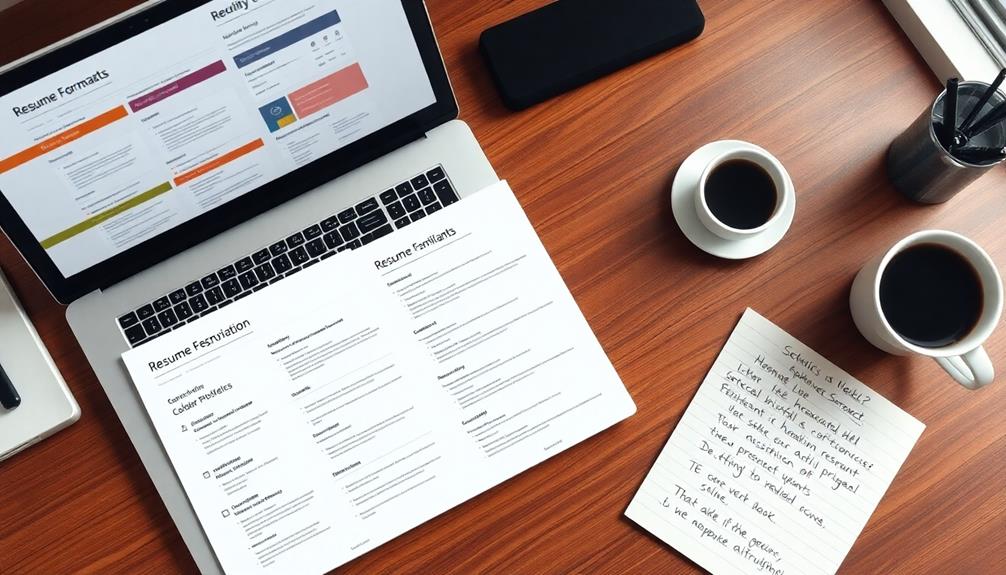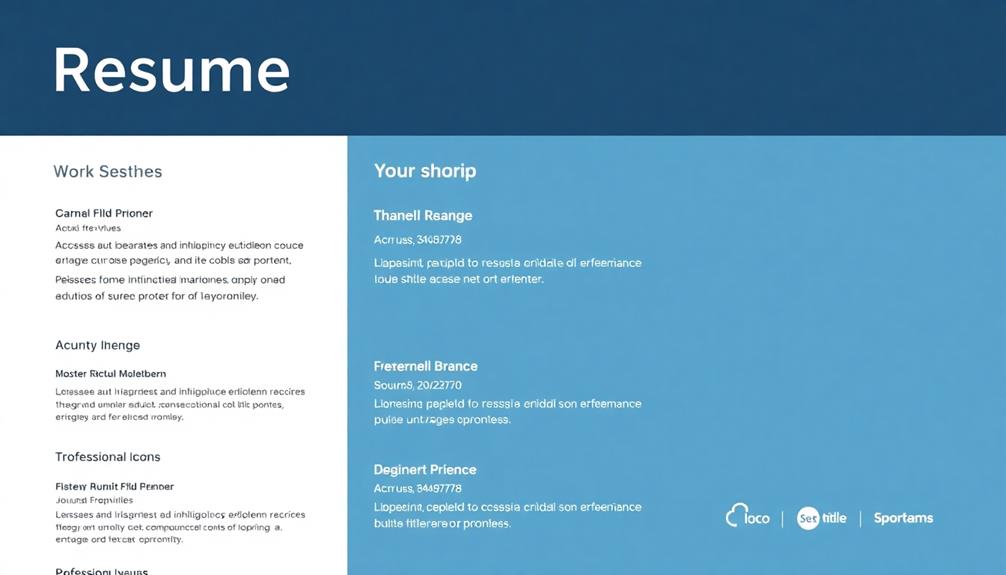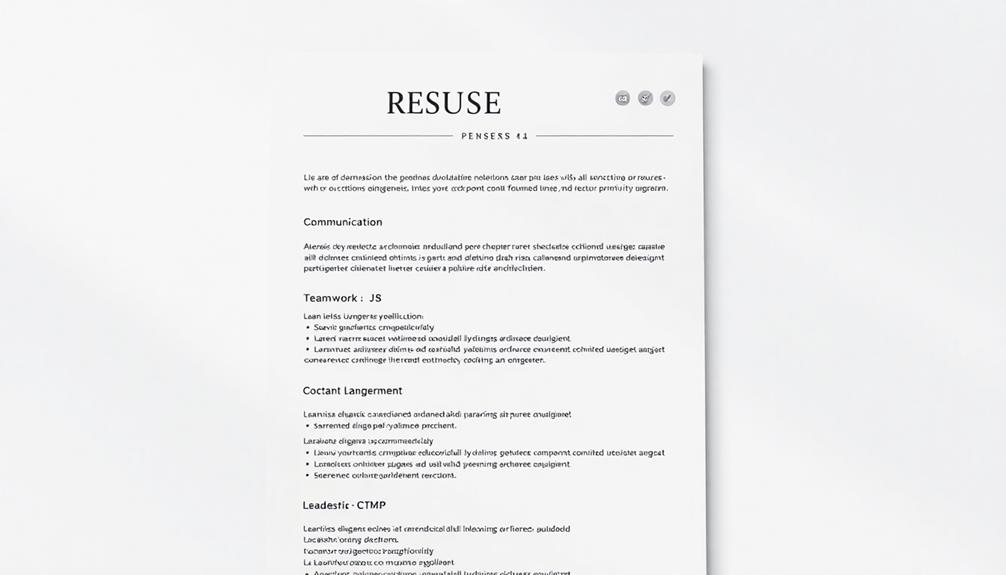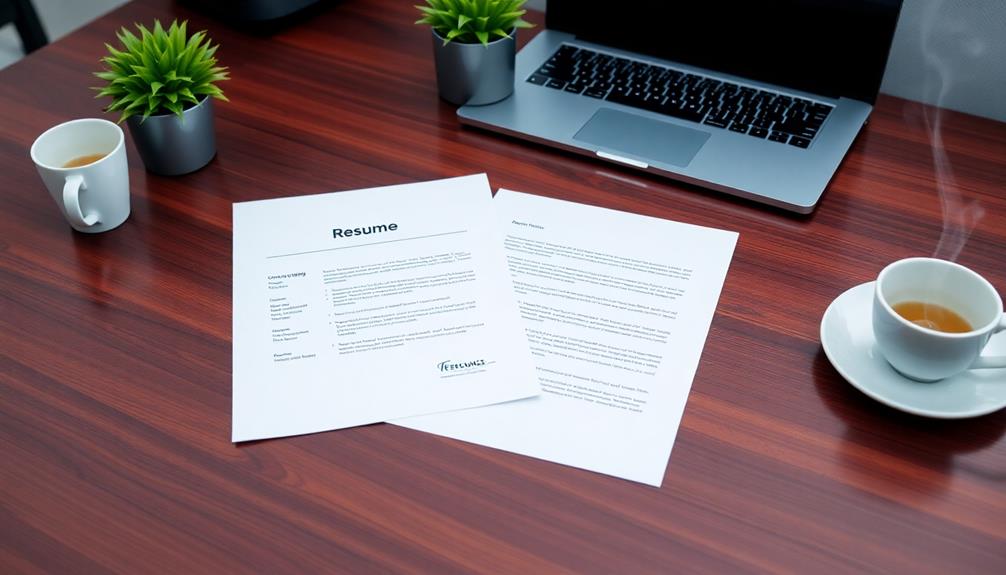To create the perfect resume, start by gathering relevant information like job titles and accomplishments. Structure it clearly with sections for contact details, a professional summary, work experience, skills, and education. Choose a format that fits your work history, prioritizing ATS compatibility. Write a compelling summary highlighting your strengths, and use bullet points to present your work experience and key responsibilities clearly. Don't forget to showcase both hard and soft skills. Finally, proofread meticulously to catch errors, and consider using professional templates for a polished look. Discover how to elevate your resume even further.
Key Takeaways
- Gather measurable accomplishments, job titles, employment dates, and educational credentials for a strong foundation.
- Tailor your professional summary and work experience sections using relevant keywords from job descriptions.
- Choose an appropriate resume format that aligns with your work history and industry expectations.
- Emphasize both hard and soft skills relevant to the targeted job, ensuring clarity in your skills section.
- Proofread thoroughly, seeking feedback from peers to catch mistakes that could lead to job rejection.
Resume Preparation and Structure

When crafting your resume, start by gathering all relevant professional information to create a solid foundation. This includes measurable accomplishments, job titles, employment dates, and educational credentials. A well-organized resume structure is essential, so make certain you have clear sections such as contact information, a professional summary, work experience, skills, and education.
Consistency in formatting helps maintain readability. Additionally, focusing on content quality and topical authority won't only improve the effectiveness of your resume but can also enhance your overall personal branding.
In your professional summary, briefly highlight your key strengths and career goals, setting the tone for the rest of your resume. When detailing your work experience, use bullet points to clearly outline your achievements and responsibilities. Incorporate action verbs to create impactful statements that showcase your contributions effectively.
Tailor your resume for each job application by incorporating relevant keywords from the job description. This alignment will demonstrate that your skills and experiences match the position's requirements.
Remember to maintain a concise and organized format, ideally limiting your resume to one page. This keeps it skimmable for hiring managers who often spend only seconds reviewing each document. A well-structured resume can greatly improve your chances of landing an interview.
Choosing the Right Format

When you're choosing a resume format, think about how it aligns with your work history and the job you're applying for.
A chronological format highlights your career progression, while a functional format focuses on your skills, which can be great if you're changing careers.
Tailoring your format to fit the job and industry standards will make your resume stand out to hiring managers.
Resume Format Types
Choosing the right resume format is essential, as it can greatly impact how effectively you present your qualifications to potential employers. Here are the main resume format types you might consider:
| Format Type | Best For | Key Features |
|---|---|---|
| Chronological Resume | Consistent work history | Lists jobs in reverse order |
| Functional Resume | Gaps in employment or career changes | Focuses on skills and qualifications |
| Combination Resume | Experienced professionals | Merges skills overview with work history |
| Visual Resume | Creative fields | Engaging graphics but must be clear |
The chronological resume format is ideal for candidates with a solid employment record and relevant experience. In contrast, the functional resume is beneficial if you have gaps in your work history or are switching careers. The combination resume allows you to showcase both your skills and detailed work history, making it suitable for diverse professionals. Keep in mind that ATS compatibility is critical, so choose a straightforward design to guarantee your resume is parsed correctly. Select the format that best highlights your strengths and fits your career situation.
Tailoring for Job Applications
Selecting the right resume format can greatly influence your chances of landing an interview. When you tailor your resume format to match the job you're applying for, you increase your chances of catching the hiring manager's eye.
A chronological format is ideal if you have a steady work history, as it highlights your career progression. However, if you're changing careers or have gaps in employment, consider a functional format that emphasizes your skills.
Combination resumes are excellent for seasoned professionals, allowing you to showcase both your relevant skills and detailed work history. Remember, tailoring your resume to the specific industry is crucial; creative fields might appreciate visually appealing designs, while traditional sectors often prefer straightforward layouts.
Don't forget about ATS (Applicant Tracking System) compatibility. Incorporate relevant keywords from the job description within your resume summary and throughout your document to help it pass initial screenings.
A well-chosen format prioritizes clarity and readability, ensuring key sections like work experience, skills, and education stand out for quick reference. By selecting the right format and tailoring your content, you'll make a strong impression on potential employers.
Writing a Compelling Summary

Crafting a compelling summary can set the tone for your entire resume, making it vital to tailor it specifically to the job you're applying for. Your summary should highlight key qualifications and skills that directly align with the employer's needs, ideally in 1-3 concise sentences.
Consider incorporating elements of effective storytelling to engage the reader, similar to techniques used in public speaking, which emphasizes audience engagement strategies.
Use active language and avoid vague statements. Instead of saying, "experienced in sales," specify your achievements, like "achieved 150% of sales targets over two consecutive quarters." This clarity will make your summary stand out.
Focus on your unique selling points that differentiate you from other candidates, such as specialized training or significant accomplishments in your field. This is your chance to grab attention immediately.
Incorporate relevant keywords from the job description to enhance compatibility with Applicant Tracking Systems (ATS) that many employers use for initial resume screening. This step is imperative in ensuring your resume gets noticed.
Lastly, remember to regularly update your summary to reflect new skills, experiences, and career goals. Keeping it relevant as your career progresses will help maintain its impact. A well-crafted summary can be your ticket to landing an interview!
Highlighting Work Experience

When you highlight your work experience, it's crucial to present it in a way that captures the attention of hiring managers quickly. Start by listing your work experience in reverse chronological order. Include the company name, location, job title, and employment dates for clarity. This structure helps employers grasp your career progression at a glance.
Understanding the importance of advance directives in planning can similarly guide your career path by making sure you highlight the right experiences.
Use bullet points to summarize your key responsibilities and achievements for each position. Keep these points concise and impactful. Don't forget to quantify accomplishments whenever possible; for example, you might say you "increased sales by 30% within one year" or "managed a team of 10." These metrics demonstrate tangible results and make your contributions more compelling.
Tailor this section to reflect the skills and experiences most relevant to the job you're applying for. Pay close attention to the job description and incorporate relevant keywords to make certain your work experience aligns with what the employer seeks.
Showcasing Relevant Skills

In showcasing relevant skills, you want to emphasize a blend of hard and soft skills that directly relate to the job you're targeting. This approach not only strengthens your resume skills section but also increases your chances of passing through applicant tracking systems.
Here's how to effectively highlight a mix of hard and soft skills:
- Analyze the Job Description: Identify key skills mentioned and match them with your own.
- Prioritize Transferable Skills: Focus on 6-8 skills that showcase your versatility and adaptability.
- Provide Context: Briefly explain how you acquired and applied these skills in previous roles.
- Update Regularly: Keep your skills section current to reflect industry demands and trends.
Education and Certifications

How can you effectively showcase your educational background and certifications to stand out in a competitive job market? Start with your education section, where you clearly list your highest level of education completed, such as degrees, diplomas, or certifications. Make sure to include the institution name, location, and graduation date, as this provides a thorough view of your academic achievements.
Don't forget to highlight relevant coursework, honors, or awards that demonstrate specific knowledge or skills applicable to the job you're pursuing. If you hold any professional certifications or licenses, include these as well, detailing the issuing organization and the dates achieved. This will showcase your specialized qualifications and enhance your candidacy.
If you're currently pursuing a degree or certification, indicate this with "in progress" notation. This reflects your commitment to ongoing professional development, which many employers value.
Keep your education section organized and straightforward. Unless you're a recent graduate, place it towards the bottom of your resume. By following these guidelines, you'll present a polished education section that effectively communicates your qualifications and dedication to potential employers.
Proofreading Your Resume

When you're proofreading your resume, watch out for common mistakes that can cost you the job.
Use tools for error checking, but remember they can miss context-specific errors.
Getting fresh eyes on your resume can also reveal issues you might've overlooked, so don't hesitate to ask for feedback.
Common Mistakes to Avoid
Proofreading your resume is essential for making a strong impression, as even minor mistakes can lead to rejection.
In fact, 80% of hiring managers view typos and grammatical errors as deal-breakers. To help you avoid common pitfalls, here are four mistakes to watch out for:
- Overreliance on Spell Check: While spell-checking tools are helpful, they won't catch every contextual error. Always do a manual proofreading afterward.
- Ignoring Formatting Consistency: Confirm your font styles, sizes, and spacing are uniform throughout. Inconsistent formatting can distract hiring managers and detract from your professionalism.
- Neglecting Fresh Perspectives: Don't hesitate to ask trusted mentors or peers for feedback. They might catch errors you've overlooked and offer insights on clarity and structure.
- Rushing the Process: Take your time when proofreading. Read through your resume multiple times and consider reading it backward to focus on each word individually.
Tools for Error Checking
After addressing common mistakes, it's time to explore effective tools for error checking your resume. Start by utilizing spell-checking tools to catch common spelling errors, but don't rely solely on them. They often miss contextual mistakes that can undermine your professionalism.
One effective strategy is to read your resume backward, helping you focus on individual words and identify overlooked typos or grammatical issues.
Consider printing your resume out for a thorough review on paper. This method allows you to spot formatting inconsistencies and mistakes that mightn't be as visible on a screen.
Additionally, seek feedback from trusted colleagues or mentors; their fresh perspectives can help catch errors you may have missed.
For an added layer of scrutiny, don't hesitate to explore professional proofreading services or specialized software for resume editing. These resources can provide valuable insights and guarantee your document is polished and error-free.
Importance of Fresh Eyes
Having someone else review your resume can make a world of difference. Fresh eyes can spot errors and inconsistencies you might miss, ensuring your professional resume stands out. Consider these points:
- Valuable Insights: Trusted peers or mentors can highlight areas for improvement that you may overlook.
- Typos Matter: Studies show 80% of hiring managers reject resumes due to typos and grammatical errors. Proofreading is essential.
- Backward Reading: Reading your resume backward helps focus on individual words, catching mistakes that affect clarity and professionalism.
- Manual Over Automated: While spell-checkers can help, manual proofreading is vital for identifying nuanced grammar and style issues.
Incorporating feedback and ensuring thorough proofreading can enhance the impact of your resume. A fresh perspective not only clarifies your qualifications but also aligns your document with industry standards.
Utilizing Templates and Tools

Many job seekers find that utilizing professional resume templates and tools can greatly simplify the resume creation process. A well-designed resume template streamlines your layout, making it visually appealing and ensuring you capture hiring managers' attention.
Online resume-building tools often offer step-by-step guidance, helping you incorporate best practices in formatting, content structure, and keyword optimization for ATS compatibility. These tools can save you time, as many resume templates come with pre-written phrases and bullet points tailored to specific industries.
You can easily customize these elements to fit your experience and skills, making your resume more effective. Additionally, using templates enhances consistency in font style and size throughout your document, contributing to overall readability and professionalism.
Importance of a Cover Letter

While a polished resume is essential, a well-crafted cover letter can enhance your application and provide a fuller picture of who you're as a candidate.
Here's why you shouldn't overlook this critical component:
- Deeper Insights: A cover letter allows you to elaborate on your experiences and career goals.
- Address Concerns: You can explain employment gaps or career changes in a narrative that a resume can't provide.
- Personalization: Tailoring your cover letter for each application greatly boosts your chances—56% of hiring managers prefer candidates who do this.
- Showcase Achievements: Including specific examples of your achievements and aligning them with the job description helps you stand out.
Frequently Asked Questions
How to Make a Perfect Resume Step by Step?
To make a perfect resume, gather your professional info, choose a suitable format, craft a strong summary, organize your experience with bullet points, and highlight relevant skills using keywords from the job description.
How Do I Make Sure My Resume Is Perfect?
To nail your resume, think of it like assembling a time machine. Tailor it for each job, use clear formatting, highlight measurable achievements, proofread meticulously, and consider professional templates for a polished look. You've got this!
What Are the 7 Basic Steps to Write a Resume?
To write a resume, gather your professional details, choose a format, create a summary, list work experience in reverse order, highlight achievements, include relevant skills, and customize keywords to match the job description.
How to Write a Flawless Resume?
To write a flawless resume, start with a strong summary that highlights your skills. Organize your experience clearly, focus on relevant skills, and proofread carefully. Tailor everything to the job you're applying for.
Conclusion
In crafting your resume, remember it's your personal brand—make it shine like a diamond in a sea of rhinestones. By following these tips, you'll create a compelling document that catches the eye of hiring managers. Don't forget to proofread and tailor your resume for each application; it's a simple yet effective way to stand out. And just like a classic typewriter, a well-structured resume never goes out of style. Now, go ahead and land that dream job!










